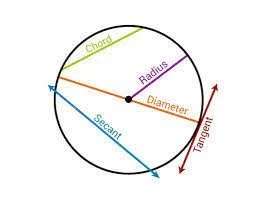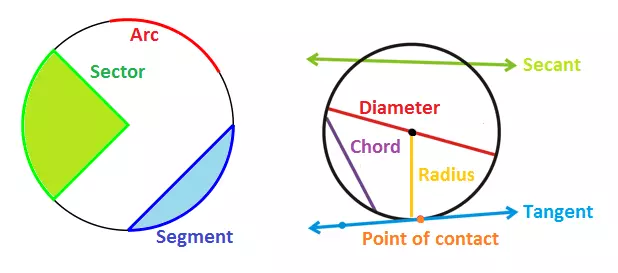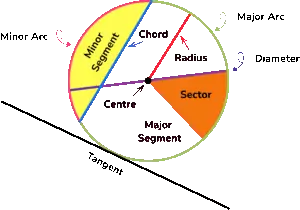A circle is a kind of flat figure that is curved. Each point in the process is located equal to the circle’s center, a fixed point on the map. The radius is the unit of measurement for this form, which is two-dimensional. The Latin term “circulus,” which translates to “little ring,” is whence we get our English word “circle.”
A circle is a figure constructed in two dimensions by a series of points located on the plane at a constant or at a determined distance (radius) from a fixed point that serves as the circle’s center. The selected issue is referred to as the origin of the process or the circle’s center, and the distance from that each point is fixedly separated from the source is referred to as the radius. [1]
Concept of Circle
In mathematics and geometry, a circle is a specific kind of ellipse with an eccentricity of zero and two centers that coincide with one another. One definition of a circle describes it as the locus of points drawn at equal distances from the center of the circle.
The radius of a circle is measured as the distance from the circle’s center to the line that encircles it. The process may be divided into two equal pieces using a bar called the diameter, which is similar to twice the length of the circle’s radius.
Because it only exists in two dimensions, the circle may be described by its area and perimeter. The distance that goes all the way around the circle is known as the circumference, which is another title for the circle’s edge. The region the circle completely encloses on a two-dimensional plane is called its area. Let’s go into the definition of the circle, some formulae, some of its most significant terminology, and some instances.
Formula of Circle
A circle is a closed 2D figure or shape in which the set of all the points in the plane is the same distance away from a specified matter that is referred to as the “center.” The line of reflection symmetry is formed by any line that travels across the circle from one side to the other.
In addition, it has rotational symmetry around the center in every direction. The following equation represents the circle formula in the plane:
(x – h)2 + (y – k)2 = r2
Where x and y represent the coordinates of the points, h, and k represents the coordinates of the circle’s center, and r represents the radius of the process.
Properties of Circle

A circle is something that everyone is familiar with. We may not realize how significant rings are and how the unique characteristics of a circle make it applicable in several settings due to its various features. It is essential to have a firm grasp of the aspects of a process if one is to have any hope of comprehending the problem-solving and information-gathering potential of this one-of-a-kind shape.
A shape with the same space separating all its points from its center is known as a circle. The absence of corners results in the formation of a round shape. It is possible to call processes after the point in their centers to distinguish them from one another.
Circles may be whatever size you want, and you can differentiate between them further by calculating the area and the transversals.
Let’s go on to the next step and learn about some of the fascinating characteristics of circles that set them apart from other geometric forms. The following is a list of attributes that a process possesses:
- A circle is an example of a closed, non-polygonal form that may be found in two dimensions. It just has one curved face.
- When two circles have the same radius, we say that they are congruent with one another.
- When drawn on a circle, equal chords are always drawn at the same distance from the circle’s center.
- In a circle, the perpendicular bisector of a chord cuts across the circle’s center.
- If two circles cross, the line that connects their center points will be perpendicular to the chute that connects the points where the circles meet.
- Drawing tangents at the extremities of the diameter results in lines that are parallel to one another.
Area of a Circle
The quantity of space inside a circle’s confines is referred to as its area. The length of its radius is the most critical factor in this regard.
Area = πr2 square unit
Parts of Circle

For a complete understanding of the qualities possessed by a circle, we need to be familiar with its various segments or components.
The following are the primary components that make up a circle:
- Circumference
- Radius of circle
- Diameter
- Chord of a circle
- Tangent
- Secant
- Arc of a circle
- The segment in a circle
- A sector of a circle
Circumference
It is possible to define it as the distance that goes all the way around the rim of the circle, which is why it is also known as the perimeter of a process.
The Radius of the Circle
The distance that must be covered to reach any point on the circumference of a circle is referred to as its radius. Because the radius measures the distance from the circle’s center and intersects the ring’s rim in several places, a process has multiple radii.
Diameter
The diameter of a circle is the straight line that links two places on the circumference of the process and runs through the center of the circle. It is essential to point out that the ring may have more than one diameter, but those diameters should:
- Across the middle of the area.
- Have a linear appearance.
- Make contact with the edge of the circle at two separate locations instead of one another.
Chord of a Circle
Any line segment that touches the circle at two distinct locations on its border might be considered a chord. The circle’s diameter is the type of chord that is the longest overall, as it runs through the middle of the process and splits it into two halves.
Tangent
A line is tangent if it contacts the circle’s circumference at a place distinct from any other point on the rim.
Secant
The secant is the name given to the line with the property of intersecting two locations on the arc or circumference of a circle.
Arc of a Circle
One segment or section of the circumference of a circle is referred to as a curve. This segment or section is an arc of the process.
The Segment in a Circle

In a circle, the term “segment” refers to the region surrounded by the chord and the corresponding arc. There are two different categories of segments: major segments and minor segments.
The Sector of a Circle

The region surrounded inside a circle by two radii and the arc that corresponds to them is referred to as the sector of the process. There are two categories of sectors: the main and the tiny sectors.
Transversals of a Circle
Because circles are made up of a collection of points that are all the same distance from the center point, it is simple to work out the angles and lines that are included inside a circle. Transversals are the name given to these lines. To clarify, a transversal is a line that crosses two or more lines, and it is possible for a transversal to either exists inside of a circle or to be utilized to locate a process.
Within the sequence of lines, angles may be measured and defined with the assistance of transversals. Finding out the geometry of circles requires just the measurement of these angles.
Three hundred sixty degrees make up a circle, whereas one hundred eighty degrees make up a half circle. The result of measuring angles produced when transversals cross one another will always be a circle, but the junction point need not always be in the middle of the process.
There is also the possibility of constructing transversals to determine the size of a particular circle sector.
It is feasible to locate and measure a circle if the transversals of the process are situated first, and then the angles of the ring are measured. To put it another way, the geometry of the call may be determined by measuring the lines where they cross. The angles that can be measured fall into one of three categories. On the same parts of the lines, you’ll find tips that correspond. Alternate interior angles are located on the sections of the lines between the two opposite lines. There are different external viewpoints on the two other places outside the lines.
Once the radius has been determined, it is possible to identify every geometric feature of the circle by applying the associated data inside the correct equation and measuring these angles. This establishes that the ring exists and can be used to find every geometric aspect of the process.
